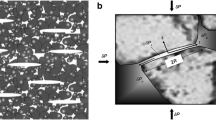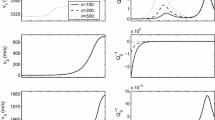Abstract
A unified theory of global and squirt flow in cracked porous media was developed several years ago on the basis of a combination of the dynamic T-matrix approach to rock physics. The theory has been successfully used to model ultrasonic velocity and attenuation anisotropy measurements in real rocks under pressure. At the same time, it was recently pointed out that this theory, which contain an established theory of interconnected cracks as a special case contains an error related to fluid mass conservation. The error was recently corrected, and this paper represents an attempt to perform a systematic study of the implications of unified theory for the relative importance of global and squirt flow in cracked porous media characterized by different microstructures and fluid mobilities. Our numerical results suggest that squirt flow dominates over global flow and global flow appears to be more important at higher frequencies for more realistic models of microstructure. The attenuation peak of squirt flow move towards lower frequencies with the increasing fluid viscosity i.e. changing saturating fluid from water to oil, while the global flow attenuation peak move towards higher frequencies with increasing fluid viscosity. A previous observation of negative velocity dispersion in unified theory still remain, even if we use the correct effective wave number, when dealing with the phenomenon of wave-induced fluid flow in models of cracked porous media where global flow effects dominates. The attenuation peak of the global flow obtained using the correct wave number is always shifted to the left as compared to the approximate solution. At seismic frequencies global flow effects are not so important and needs very high permeability and low viscosity to have an effect.










Similar content being viewed by others
References
Agersborg R, Jakobsen M, Ruud BO, Johansen TA (2007) Effects of pore fluid pressure on the seismic response of a fractured carbonate reservoir. Stud Geophys Geodaetica 51:89–118
Agersborg R, Johansen TA, Jakobsen M, Sothcott J, Best A (2008a) Effects of fluids and dual-pore systems on pressure-dependent velocities and attenuations in carbonates. Geophysics 73:N35–N47
Agersborg R, Johansen TA, Ruud BO (2008b) Modelling reflection signatures of pore fluids and dual porosity in carbonate reservoirs. J Seism Explor 17:63–83
Auld BA (1990) Acoustic Fields and Waves in Solids. Krieger Publishing, Malabar
Biot MA (1956) Theory of propagation of elastic waves in a fuid saturated porous solid. I. Low frequency range and II. Higher-frequency range. J Acoust Soc Am 28:168–191
Biot MA (1962) Mechanics of deformation and acoustic propagation in porous media. J Appl Phys 33:1482–1498
Carcione JM (1995) Constitutive model and wave equations for linear, viscoelastic, anisotropic media. Geophysics 60:537–548
Carcione JM (2007) Wave fields in real media: wave propagation in anisotropic, anelastic, porous and electromagnetic media. Elsevier, Amsterdam
Chakraborty A (2008) Prediction of negative dispersion by a nonlocal poroelastic theory. J Acoust Soc Am 123:56–67
Chapman M (2001) Does fluid viscosity influence seismic velocity? In: 63rd Annual international EAGE meeting, Amsterdam, 11–15 June 2001
Chapman M (2003) Frequency dependent anisotropy due to meso-scale fractures in the presence of equant porosity. Geophys Prospect 51:369–379
Chapman M, Zatsepin VS, Crampin S (2002) Derivation of a microstructural poroelastic model. Geophys J Int 151:427–451
Dvorkin J, Nur A (1993) Dynamic peorelasicity: a unified model with the squirt and Biot mechanism. Geophysics 58:524–533
Dvorkin J, Nolen-Hoeksema R, Nur A (1994) The squirt flow mechanism: macroscopic description. Geophysics 59:428–438
Dvorkin J, Mavko G, Nur A (1995) Squirt flow in fully saturated rocks. Geophysics 60:97–109
Gurevich B, Brajanovski M, Galvin RJ, Müller TM, Toms-Stewart J (2009) P-wave dispersion and attenuation in fractured and porous reservoirs—poroelasticity approach. Geophys Prospect 57:225–237
Hudson JA, Liu E, Crampin S (1996) The mechanical properties of materials with interconnected cracks and pores. Geophys J Int 124:105–112
Jakobsen M (2004) The interacting inclusion model of wave-induced fluid flow. Geophys J Int 158:1168–1176
Jakobsen M (2007) Effective hydraulic properties of fractured reservoirs and composite porous media. J Seism Explor 16:199–224
Jakobsen M, Chapman M (2009) Unified theory of global and squirt flow in cracked porous media. Geophysics 74:WA65–WA76
Jakobsen M, Hudson JA (2003) Visco-elastic waves in rock-like composites. Stud Geophys Geodaetica 47:793–826
Jakobsen M, Hudson JA, Johansen TA (2003a) T-matrix approach to shale acoustics. Geophys J Int 154: 533–558
Jakobsen M, Johansen TA, McCann C (2003b) The acoustic signature of fluid flow in complex porous media. J Appl Geophys 54:219–246
Klimentos T, McCann C (1988) Why is the Biot slow compressional wave not observed in real rocks? Geophysics 53:1605–1609
Maultzsch S, Chapman M, Liu ER, Li XY (2003) Modelling frequency-dependent seismic anisotropy in fluid-saturated rock with aligned fractures: implication of fracture size estimation from anisotropic measurements. Geophys Prospect 51:381–392
Maultzsch S, Chapman M, Liu E, Li XY (2007) Modelling and analysis of attenuation anisotropy in multi-azimuth VSP data from the Clair field. Geophys Prospect 55:627–642
Mavko G, Jizba D (1991) Estimating grain-scale fluid effects on velocity dispersion in rocks. Geophysics 56:1940–1949
Mavko G, Nur A (1975) Melt squirt in the asthenosphere. J Geophys Res 80:1444–1448
Mukerji T, Mavko G (1994) Pore fluid effects on seismic velocity in anisotropic rocks. Geophysics 59:233–244
Müller TM, Gurevich B, Lebedev M (2010) Seismic wave attenuation and dispersion resulting from wave-induced flow in porous rock—a review. Geophysics 75:75A147–75A164
O’Connell RJ, Budiansky B (1977) Viscoelastic properties of fluid-saturated cracked solids. J Geophys Res 82:5719–5735
Pointer T, Liu E, Hudson JA (2000) Seismic wave propagation in cracked porous media. Geophys J Int 142:199–231
Shahraini A, Ali A, Jakobsen M (2010) Characterization of fractured reservoirs using a consistent stiffness-permeability model: focus on the effects of fracture aperture. Geophys Prospect 59:492–505
Van Golf-Racht TD (1982) Fundamentals of fractured reservoirs engineering. Elsevier, Amsterdam. ISBN 0444416250
Winkler KW (1985) Dispersion analysis of velocity and attenuation in Berea sandstone. J Geophys Res 90:6793–6800
Xi D, Liu X, Zhang G (2007) The frequency (or time)-temperature equivalence of relaxation in saturated rocks. Pure Appl Geophys 164:2157–2173
Acknowledgments
Dr. Aamir Ali would like to thank Higher Education Commission (HEC), Pakistan, and Department of Earth Sciences, University of Bergen, Norway, for providing the necessary funding to complete this work.
Author information
Authors and Affiliations
Corresponding author
Appendices
Appendix 1: Christoffel equation for viscoelastic media
From Hooke’s law the stress-strain relation can be written as using the matrix notation (Carcione 2007)
where \(\sigma \) is the stress tensor, e is the strain tensor and C is the stiffness tensor. The equation of motion in the absence of body forces can be written as (Carcione 2007)
where
where u is the displacement vector and the symmetric gradient operator \(\nabla \) using the matrix representation is given by Auld (1990) and Carcione (2007)
The strain displacement relation is given by Carcione (2007)
A general plane wave solution for the displacement vector of the body waves is given by Carcione (2007)
where \(\mathbf{u}_0\) represents a constant complex vector, \(\omega \) is the angular frequency and k is the wave-number vector. The particle velocity is given by time derivative of Eq. (36) given by
In the absence of body forces \((\mathbf{f}=0)\), we consider plane waves propagating along the direction given by Carcione (2007)
where \(l_{1}, l_{2}\) and \(l_{3}\) are the direction cosines. The wave-number vector k can be written as (Carcione 2007)
where \(k\) is the magnitude of the wave-number vector. The spatial differential operator in Eq. (34) can be replaced by
Now substituting the time derivative as \(\partial _{t}\rightarrow i\omega \) and using Eq. (40) in Eq. (32), we get (Carcione 2007)
where
is the Christoffel matrix. The dispersion relation is given by (Carcione 2007)
where
is the complex velocity.
Equation (43) is known as the Christoffel equation. Using Eq. (44), the components of the slowness and attenuation vectors can be expressed in terms of the complex velocity as (given by Carcione 1995)
and
Appendix 2: The effective permeability tensor
The effective permeability tensor \(\mathbf{K}^{*}\)of the fractured porous reservoir model, assuming that the distribution of fractures is same for all fracture families is given by Jakobsen (2007)
where
Here, \(\mathbf{K}^{(0)}\) is background or matrix permeability, \(\mathbf{I}_2\) is the (Kronecker-delta) identity for second rank tensors, \(v^{(r)}\) is the volume concentration for fractures of type \(r\) and \(\mathbf{g}_d\) is a tensor given by the strain Green’s function integrated over an ellipsoid determining the symmetry of the correlation function for the spatial distribution of fractures (see Jakobsen 2007; Shahraini et al. 2010). The \(\tau ^{(r)}\) for a single fracture of type \(r\) is given by Jakobsen (2007)
Here, \(\mathbf{g}^{(r)}\) is a second-rank tensor given by the pressure gradient Green’s function integrated over a characteristic spheroid having the same shape as inclusions of type \(r\) (see Jakobsen 2007; Shahraini et al. 2010), and \(\mathbf{K}^{(r)}\) is a second-rank tensor of permeability coefficients for fractures of type \(r\), which can be estimated using the cubic law given by Golf-Racht (1982)
Here \(a\) represents the aperture of the fractures of type \(r\).
Rights and permissions
About this article
Cite this article
Ali, A., Jakobsen, M. On the relative importance of global and squirt flow in cracked porous media. Acta Geod Geophys 49, 105–123 (2014). https://doi.org/10.1007/s40328-014-0049-5
Received:
Accepted:
Published:
Issue Date:
DOI: https://doi.org/10.1007/s40328-014-0049-5




